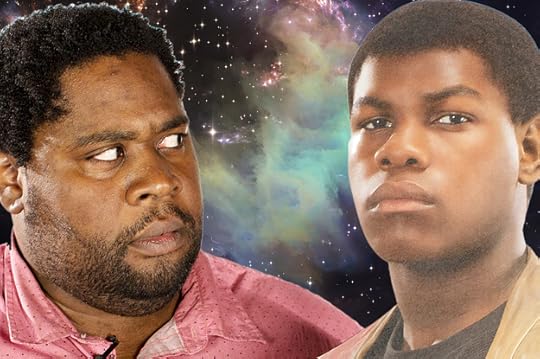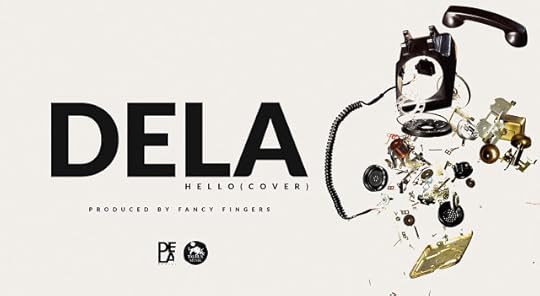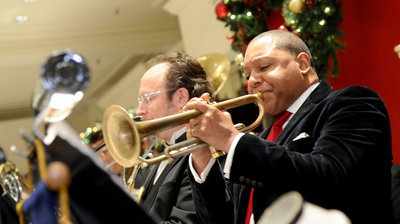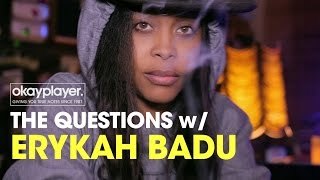Mark Anthony Neal's Blog, page 662
December 20, 2015
Satire and Redemption: Reading Spike Lee's Chi-Raq
 Satire and Redemption: Reading Spike Lee's Chi-Raqby Joseph Winters | HuffPost Black Voices
Satire and Redemption: Reading Spike Lee's Chi-Raqby Joseph Winters | HuffPost Black VoicesIt is never easy to articulate an initial response to a Spike Lee film. His films are not conducive to the formulaic "Did you like it or not?" question. A Spike Lee "joint" can be overwhelming, frustrating, hilarious, trenchant, unfinished, and haunting.
In opposition to most of the films produced by the Hollywood machine, Lee's works leave fans and detractors with lingering tensions and frictions - and occasionally a glaring silence. I experienced this last fall when I taught Lee's early works in my race and film class.
After teaching Do the Right Thing (1989) during the second week of class (and juxtaposing the police choke hold, and killing, of the character Radio Raheem with the image of Eric Garner being choked to death by officers), I was disappointed by my inability to spark a vibrant conversation about the film. Students seemed uninterested and unmoved. Later in the course, as students began to get more comfortable, they confessed that a film like Do the Right Thing was "too much" to handle. The scenes, dialogues, themes, and format of the film incited a kind of discomfort, a protracted moment of silence that reminds us that certain experiences cannot immediately find the words for normal expression.
Lee's new film, Chi-Raq, might not be "likable" but it definitely follows his previous films as it prompts viewers to think critically about unresolved tensions and problems in the film and the broader social world. Inspired by Aristophanes' play Lysistrata and taking the form of a musical satire, Chi-Raq centers around a group of women who refrain from having sex with their boyfriends as an incentive to end the cyclical gang violence.
Through satire, the film plays on racial and gender stereotypes while drawing attention to America's internal wars, the all too familiar deaths and losses experienced in cities like Chicago. There is much in the film that both fascinates and disappoints; I am particularly interested in three aspects that pertain to the film and its critics: the complexity of representation, the use of the term Chi-Raq, and the theme of salvation in the film.
One criticism that has been directed toward the film, especially by Chicago natives, is that it is exploitative; it turns the complicated, and serious, realities of Chicago into a satire and musical. Some have even questioned Lee's authority to speak about the city - he is an outsider and does not have intimate knowledge of the city's problems. What is interesting is how the concern about the inappropriateness of satire resembles Lee's dismissal of Quentin Tarantino's 2012 film, Django Unchained.
In one interview, Lee revealed that he would not see Django because it would be disrespectful to his ancestors. He suggested that part of the disrespect lies in Tarantino's decision to turn slavery into a spaghetti western. In other words, Lee suggests that the western cannot properly represent the horrors of slavery in the same way that critics of Chi-Raq claim that a musical, or Greek comedy, fails to capture Chicago's present circumstances. This brings up important questions about representation and genre that we should be talking about. What would a proper cinematic depiction of Chicago look like? Is the supposed disconnect between the musical genre, or Greek comedy, and the "reality" of violence part of the film's satire and parody? Does the gap between genre and content get at the complexities of the present moment? Who gets to represent a community and what counts as a proper, or improper, depiction?
Another source of contention is the use of term "Chi-Raq." In a provocative article recently written by Mychal Denzel Smith in The Nation, the author accuses Lee of uncritically adopting this term from Chicago rappers, a term that naturalizes violence in Iraq and denies America's involvement in creating that violence. Smith rightly points out that the beginning of the film compares the numbers of American soldiers who have died in Iraq and Afghanistan to deaths in Chicago without mentioning deaths of Iraqis or Afghans. While I agree with much of Smith's analysis, he leaves out some things.
For one, there is a long legacy (beyond Chief Keef ) in hip hop culture of invoking Middle Eastern places as signifiers of violence and zones of war. Think for instance of Capone and Noreaga's 1997 album War Report where Lefrak City, Queens is referred to as Iraq. When hip hop artists make these connections and analogies, they don't simply naturalize war in the Middle East. They also show the continuities between violence elsewhere and violence at home, a tactic that troubles notions of American exceptionalism and that links local and global expressions of violence and suffering. Lee's Chi-Raq gestures toward these connections in the beginning of the film as we are shown an image of America composed of guns pointing in all directions. Guns are pointing beyond the borders of the U.S. suggesting that the production and consumption of weapons in this country has global effects. And the fact that the women in the film, led by Lysistrata (played by Teyonah Parris), take over an armory shows that any understanding of "war" in Chicago would have to include a re-evaluation of militarism and empire.
The final aspect of the film that stands out is the theme of salvation. Recall that Spike Lee has said that he expects the film to save lives in Chicago. Throughout the film, there is a persistent concern about saving the lives of children, protecting them from the senseless bloodshed. The church plays a significant role in the film as Father Mike Corrigan (played by John Cusack and inspired by Father Michael Pfleger) gives a powerful sermon during a funeral that connects gun violence to poverty and inequality. Yet one of the most memorable scenes that pertains to salvation is the final one. Chi-raq (played by Nick Cannon) is escorted by police officers in handcuffs down a gauntlet of community mothers. He has just confessed to killing a young girl by accident.
After Chi-raq reminds the crowd that he is not the only murderer present, the viewer gets a sense that the film is playing on the scapegoat metaphor. Perhaps this scene is part of the satire, a critique of our tendency to direct blame toward individuals and shield ourselves from the problems and tensions that we share. If we can just get rid of the Chi-Raqs (communities and individuals), we will be rescued from the violence that plagues our social world. We will be cleansed of the dirt and blood that the social order produces. On my reading, this kind of convenient fantasy is what the film exposes and challenges through parody and satire.
+++
Joseph Winters is assistant professor in Religious Studies and African and African American studies at Duke University. Winters’ first book Hope Draped in Black: Race, Melancholy, and the Agony of Progress will be published by Duke University Press in 2016.
Published on December 20, 2015 17:25
Young Muslim-Americans Say Discrimination is Worse Now Than It Was After 9/11
 'Fusion’s Jorge Ramos and Alicia Menendez moderated a discussion with young, Muslim-Americans after the fifth GOP debate in Las Vegas, Nevada, and asked if they feel more discriminated now—amidst so much anti-Muslim rhetoric—than they did just a couple weeks ago.' -- +Fusion
'Fusion’s Jorge Ramos and Alicia Menendez moderated a discussion with young, Muslim-Americans after the fifth GOP debate in Las Vegas, Nevada, and asked if they feel more discriminated now—amidst so much anti-Muslim rhetoric—than they did just a couple weeks ago.' -- +Fusion
Published on December 20, 2015 07:54
Black Guys Discuss The Black Guy In Star Wars
 ”They went to a new planet, Planet Negroxe, and found a bunch of brothas.”--When Black Guys Discuss the Black Guy in the new Star Wars film.' -- +BuzzFeed
”They went to a new planet, Planet Negroxe, and found a bunch of brothas.”--When Black Guys Discuss the Black Guy in the new Star Wars film.' -- +BuzzFeed
Published on December 20, 2015 07:38
'Caught: The Prison State and the Lockdown of American Politics'
 'You already know the statistics: The U.S. incarcerates more people than any other country. But do you know why? Marie Gottschalk talks her book
Caught: The Prison State and the Lockdown of American Politics
.' -- +Big Think
'You already know the statistics: The U.S. incarcerates more people than any other country. But do you know why? Marie Gottschalk talks her book
Caught: The Prison State and the Lockdown of American Politics
.' -- +Big Think
Published on December 20, 2015 07:30
December 19, 2015
Kenyan Afro Pop Songstress Dela Maranga's Swahili Cover of "Hello"
 'Adele's global hit 'Hello' has been translated to Swahili by the talented and beautiful Queen of Afro Pop, Dela Maranga.'
'Adele's global hit 'Hello' has been translated to Swahili by the talented and beautiful Queen of Afro Pop, Dela Maranga.'
Published on December 19, 2015 12:08
#TheRemix: Islamaphobia + Donald Trump + Racializing the War on Terror
 Multi-platform journalist and producer Nida Khan joins James Braxton Peterson on
#TheRemix
to discuss recent incidents of violence against Muslims as backlash over the San Bernardino shootings and Paris attacks. Follow Khan on twitter @NidaKhanNY.
Multi-platform journalist and producer Nida Khan joins James Braxton Peterson on
#TheRemix
to discuss recent incidents of violence against Muslims as backlash over the San Bernardino shootings and Paris attacks. Follow Khan on twitter @NidaKhanNY.
Published on December 19, 2015 07:20
Christian McBride's Christmas Jazz Playlist
 'Christian McBride, host of Jazz Night In America looks for old and forgotten gems during the holiday season. He weighs in with surprisingly different and joyous tunes — plus, of course, James Brown.'
'Christian McBride, host of Jazz Night In America looks for old and forgotten gems during the holiday season. He weighs in with surprisingly different and joyous tunes — plus, of course, James Brown.'
Published on December 19, 2015 07:03
The Questions With Erykah Badu
 'Erykah Badu, better known as the Analog Girl in a Digital World talks the power of social media and the inspiration for You Cain't Use My Phone on newest installment of "The Questions" on +Okayplayer TV.'
'Erykah Badu, better known as the Analog Girl in a Digital World talks the power of social media and the inspiration for You Cain't Use My Phone on newest installment of "The Questions" on +Okayplayer TV.'
Published on December 19, 2015 06:13
December 18, 2015
NOLA to Take Down Confederate Monuments
 New Orleans city leaders called a special meeting to vote on a plan to remove the statues of confederate leaders in the city. -- +Al Jazeera America News
New Orleans city leaders called a special meeting to vote on a plan to remove the statues of confederate leaders in the city. -- +Al Jazeera America News
Published on December 18, 2015 21:52
“Nobody Beats The Wiz”: Signifyin(g) #BlackExcellence in a Moment of Anti-Blackness by I. Augustus Durham
 “Nobody Beats The Wiz”: Signifyin(g) #BlackExcellence in a Moment of Anti-Blacknessby I. Augustus Durham | @imeanswhatisays | NewBlackMan (in Exile)
“Nobody Beats The Wiz”: Signifyin(g) #BlackExcellence in a Moment of Anti-Blacknessby I. Augustus Durham | @imeanswhatisays | NewBlackMan (in Exile)As a youngster, right on Boston Post Road in Orange, I remember that electronics store called The Wiz. Its slogan: “Nobody beats The Wiz!” When I went to YouTube looking for the footage of the jingle in reference to the rebroadcast of The Wiz, I stumbled upon this commercial and thought, “Hmmm, that could be an intriguing way to reconstruct my feelings about December 3.” So, here it is:Sale: when the news broke that The Wiz would be NBC’s next live musical, some of us were skeptical; the two previous live offerings—The Sound of Music and Peter Pan—were…meh. The sale was a good and bad thing. On the one hand, it was an opportunity to nostalgically return to yesteryears of VHS and film broadcasts on Afrocentric television channels, even if the formatting of the film cut out scenes like “Be a Lion”. At the very least, the practicality of the sale was instead of purchasing the DVD or going to the musical on the great white way, one could watch “for free”. On the other hand, the nostalgic ones were confused by some of the castings: if the goal was to reinvigorate that former love by having previous Wiz kids impart that love to a new generation, members of the cast are as old as, if not older, or younger, than, those VHS-ers . . .Integrity: Admittedly, I am too young to have seen the Broadway musical, but knowing that cast, specifically the Stephanie Mills, it was nice to have that crossover of a previous Dorothy as Aunt Em—it symbolizes, albeit coincidentally, growth. Confession notwithstanding, my frame of reference is the film, and the live version had high and low moments of homage. Instead of rehashing them, what I will say is: something I learned, in a former performative life, is when one performs something renowned, unless s/he comes at it in a COMPLETELY different way, that first iteration usually trumps that piece’s performance in perpetuity. For example, as much as I love this aria, Nina will always be on replay because of its immense difference: melancholy made gorgeous, executed with genius precision. That said, the integrity of the live version left me, and perhaps others, somewhere in the middle. It was the little things, like waiting for the great MJ run (start at 2:30) that never came, even though the rendition was well-executed—a 21st century update for sure—, or the infusion of new songs to bring the musical into the age of millennials. Yet, the fantasy created still maintains that aesthetic edge, that whimsy that the black performance archive almost always accomplishes. (I still long though for a more pronounced presence of Toto!) This perhaps provides a perfect transition to the . . .Customer: Personally, the customer is not always right, but I do recall an admonition by Leontyne Price, and for that matter Ralph Ellison via Miss Hazel Harrison: there is always a little (hu)man behind the stove, or at Chehaw Station, whom one does not expect to be at the performance, and s/he knows the music, the tradition, the standards of musicianship. Price says this in different words (notice the reaction of the crowd as the Verdi aria is played!). As a watcher who live-statused that Thursday night, I, and others, presumably got it, even if the getting was just a simple reminder: Just as The Wizard of Oz only acknowledged blackness by way of animality, The Wiz, as conceived for the stage (1974/5) and the cinema (1978) then, underwent a monumental fast-forward. The gravity of it being broadcast, on television, at this moment, in This (Black) American Life, is one of the most public moments of signifyin(g) we have seen this year (this and this included). This is to say, with all of the anti-blackness that pervades our national optics ad infinitum, to have a moment when the dominant narrative is interrupted to say, “Hey y’all, nobody beats The Wiz!” is to give recitation to Kendrick Lamar: despite being down before, we continually work in excess of our pain to find a pleasure that confirms we gon’ be- done been-already-all really-are-been already alright! All right! What if The Wiz is a truncated, or extended, episode of the Soul Train franchise inasmuch as for almost three hours, a nation, which many persons find calling “home” to be catachresis, was able to see that blackness, and its art, is the hippest trip in America?Excellence: which is really #blackexcellence, is easy to trace because words have never captured that thing we all know, (ir)regardless (!) of SCOTUS bunk or people *raises hand* chronicling on social media what work, or werk, looks like. In many ways, Amber Riley (and Mills) set the tone for the night because it is difficult to follow someone singing at a 10 within the first seventeen minutes of a 2.5 hour musical—she sang so well, Toto hid until the end! Other notables: Shanice Williams—she plays Dorothy, as ingénue, refreshingly! David Alan Grier—a wonderful surprise! The transformation, both before and during the telecast, of Queen Latifah is noteworthy: what would it mean to imagine such an evolution—from queer green Wiz to homely introvert to ballooning Covergirl—as some persons’ material, everyday conditions AND choices for personal truth, rather than something to behold from a critical distance? We know more Wizes than we think, or care to acknowledge. The costuming and dancing were perhaps the most consistent aspects of the presentation, and although I hoped for the Emerald City Scene from the film (disregard the ambient commentary), the live intervention affirmed forms of contemporary sociality. (Nevertheless, here is an example of how the film and the live version could have been hybridized in my opinion.)Respect: I respect the black performance archive—I am a product of it—and that is why my DVR will be running, again, tomorrow.+++
I. Augustus Durham is a third-year doctoral candidate in English at Duke University. His work focuses on blackness, melancholy and genius.
Published on December 18, 2015 21:33
Mark Anthony Neal's Blog
- Mark Anthony Neal's profile
- 30 followers
Mark Anthony Neal isn't a Goodreads Author
(yet),
but they
do have a blog,
so here are some recent posts imported from
their feed.



